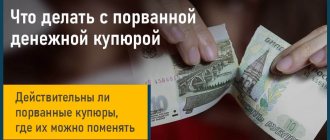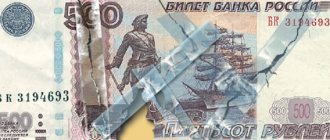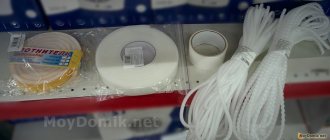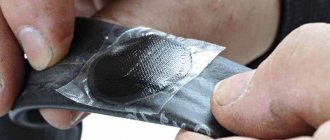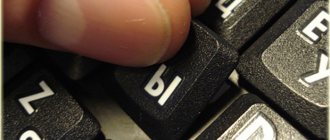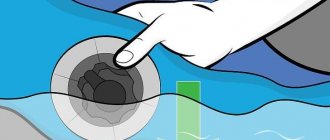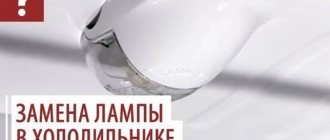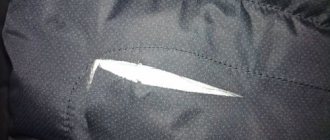You can get a torn banknote when paying for travel or in a store. And if the banknote is torn a little, then it’s okay. But what if the bill was torn when taken out of your pocket or a child tore or cut it? In this material we will tell you how you can seal a banknote, and the main thing is whether it is worth doing it, or is it easier to change it.
How to deal with a torn banknote
Torn or stained banknotes can be exchanged at any bank branch if we are talking about Russian rubles and not foreign currency. It is not necessary to contact the office of a large institution; you can come to a small branch of any bank.
To exchange a damaged banknote for a new one, go to the cashier with your passport. In some cases, you will be asked to fill out an application, but if the damage is minor and the authenticity is beyond doubt, the bill will be exchanged for another without this. If doubts about the authenticity arise, then another bill will be issued after an examination or money will be credited to your account if it is open at this bank.
A banknote can be damaged in different ways. The cashier's actions depend on how bad the money is. The banknote will be replaced without any problems if more than half of its parts are in your possession.
Tears on the banknote
Banknotes with tears can often be found. They are issued with change in stores, so it is easy to miss. Most often, tears occur on small bills that are in constant circulation. Money of larger denominations does not wear out as much. One-hundred-ruble bills are withdrawn from circulation every year, but five-thousand-ruble bills may not lose their appearance even after 5 years.
Banknotes with tears can be used to pay in other stores or at the market, but ATMs and payment terminals will not accept such banknotes. If you need to transfer money to a bank account, but do not have another banknote with you, contact the bank cashier; he will not make claims for torn money. If the tear is large enough, the banknote can be glued with tape; such money is usually accepted for payments in all stores.
Corner of banknote torn off
If the part of the bill that contains the serial number is torn off, it may not even be considered damage. But if about a third of the bill is missing, the store is unlikely to accept it. It’s better to immediately go to the bank’s cash desk and exchange the damaged one for a whole one. Banknotes with a clearly visible serial number will be accepted immediately. If any part of the serial number is missing or is difficult to see, an examination will be carried out first.
If a little more or about half of the bill has been preserved, it will not be possible to exchange it even at the bank’s cash desk. The rules are set to protect against scammers. Anyone can deliberately tear a banknote and go to a bank cashier with the expectation of receiving two banknotes instead of one. Such bills will not be exchanged at the cash register, and may even be subject to criminal liability if deliberate deception is revealed.
It is better not to take risks and not to carry banknotes smaller than 55% of the original size. But if you give the cashier two halves of bills with different serial numbers, they will be exchanged for one whole banknote.
Banknote torn in half
If you yourself accidentally tore a bill and both parts remain, do not be upset. This money is not lost, it can definitely be exchanged at the cash register. You can even carefully glue the banknote with tape and pay with it in any store. But it’s better to immediately take the bill to the bank to get whole money in return.
If you decide to take a banknote torn in half to the bank, you don’t have to glue it together, but simply present the two halves. After the cashier is convinced that the torn parts belong to the same banknote, they will immediately issue a new one.
Banknote torn into several pieces
You can exchange a banknote torn into many pieces at a bank only under certain conditions. You must have at least 55% of the whole bill. Torn parts can be glued with tape.
The bank will accept the bill if you can prove that the torn parts belong to the same bill and have the same serial number. If the identity of one banknote is doubtful, you will have to write a statement and wait for an examination. You may be prosecuted for attempted fraud.
Torn foreign banknote
It is impossible to pay in stores with a torn foreign banknote or to top up a bank account with it. The only way out is to bring it to the bank cash desk. But there is no guarantee that the bill will be exchanged for a whole one.
The fact is that the exchange of damaged foreign banknotes is not regulated by the law of the Russian Federation. It applies only to Russian rubles. Therefore, each bank can set its own rules for exchanging torn money. In some places you may be lucky and the bill will be exchanged, but in others they will refuse. And even if the bank employees agree to exchange the money, you will most likely be charged an additional commission for exchanging the damaged banknote.
Some Russians use a different scheme: they give damaged foreign banknotes to those who travel abroad. In a country where the currency is considered national, damaged money can be easily exchanged at any bank and no payment will be charged for it. No one can oblige Russian banks to accept torn banknotes from foreign countries free of charge.
Basic methods of gluing torn banknotes
In order to glue a torn banknote, there are several simple but quite effective ways.
Method No. 1
In this situation, the most ordinary stationery tape will come to your aid. It should be used if the defect is small. In the opposite case, such a repair will look quite rough and conspicuous.
To make the seam look more neat, you must follow the following procedure:
- Place the banknote on a flat surface.
- Measure the length of the break.
- Cut a piece of tape equal to the length of the tear in the bill.
- Apply tape to the torn area. This should be done very carefully so that creases do not form.
Important! Today, in office supply stores you can purchase special tape for repairing banknotes.
Method No. 2
In this case, you will only need a glue stick:
- Take a glue stick and run it only along the ends of the tear.
- Let it dry a little. After 2-4 minutes, this operation should be repeated again.
- Place two parts of the bill on the paper. Connect them carefully.
Important! Make sure that the top and bottom edges match, as well as the design on the front side.
- Using a stationery brush or cotton swab, apply a little dust (talc, starch or chalk) to the gluing areas.
Important! This is necessary so that the bill, while in the wallet, does not stick to its surface or other money.
- Leave for half an hour for the glue to dry. After the specified time has passed, you can safely go shopping, since the junction is almost invisible.
Important! You can use not only a glue stick, but also Moment glue or PVA.
Method number 3
Despite the fact that this method takes longer than the previous ones, thanks to it the seam remains invisible. In order to glue a banknote in this way, you will need:
- PVA glue;
Important! Always pay attention to the consistency of the glue. It should be quite thick, in no case liquid.
- Glass bottle;
- Iron.
How to proceed:
- To begin with, glue should be applied to the torn end of the bill. This can be done with a match or a toothpick.
Important! If you accidentally go overboard and smear glue on a bill, you can always wipe it off with a dry cloth or napkin.
- Place the bill on the bottle and connect the halves end to end. Try to match the pattern exactly and avoid overlap.
Important! You can use wax paper instead of a bottle.
- Fix the joints and go over them with the tip of a hot iron.
- Wait a few minutes for everything to cool down.
That's it, the money is ready for you to spend!
When is expertise needed when exchanging currencies?
Examination of a banknote is a check of authenticity. The service is provided at bank cash desks. If the cashier has doubts that the bill is real, he will conduct an examination free of charge. This way, bank employees can make sure that they are not dealing with a fraudster.
Without examination they exchange:
- Banknotes torn in half and glued together with tape. Provided that the parts belong to the same banknote with the same serial number.
- Torn banknotes. The number and size of damage does not matter.
- Banknotes with torn or stained edges. But the area of the lost parts should not be too large. The surviving banknote must contain a serial number.
- Punctured bills. The punctures should not be too large. If they are large, they should not be located in the place of the serial number or denomination of the banknote.
- Banknotes with minor abrasions and dirt. Even the part containing the serial number may be contaminated. But some of the signs must remain distinguishable.
You can exchange not only paper banknotes, but also coins at bank cash desks. They can be bent or modified, but must retain the design on both sides.
How to glue pages
The first thing that comes to mind when you see a torn page is tape. But it cannot be used for repairs. The glue with which the tape is smeared corrodes the paint, mold and yellow spots form underneath it, and it comes off along with the letters. A special translucent invisible tape for sealing money is suitable. It is sold in a stationery store and costs around 200 rubles. If you can't find tape, use thin strips of tracing paper and PVA.
The second way to fix a torn page is to staple it directly at the tear. To do this, lubricate the torn area with PVA paper, without going beyond the boundaries of the tear, and then align the torn edges as carefully as possible. On both sides of the sheet, along the gap, we apply thin tissue paper (it does not need to be glued), and on top - regular printing paper. Then the book is sent to the press. After 6–12 hours, remove the paper and carefully smooth out the tear area. After this procedure, the defect is almost invisible.
To remove a greasy stain from a book, sprinkle it with talcum powder and iron it through the paper.
What kind of money cannot be exchanged?
The bank may refuse to exchange a damaged banknote for several reasons:
- The banknote bears the inscription “Sample”. In this case, the inscription is printed on the banknote. If the word is written by hand, this will be considered damage or spoilage, but the bill can still be exchanged at the bank’s cash desk.
- The banknote is painted with a special paint, which is used to prevent theft from bank vaults.
- With any manufacturing defect.
- If the bill is old and has already gone out of circulation. These banknotes cannot be used to pay for purchases; they can only be kept as a souvenir.
- If 50% of the whole bill or even less is presented to the cashier...
The state constantly removes damaged banknotes from circulation. Dilapidated and torn money, although it retains signs of solvency, still becomes a problem not only for citizens, but also for banks. Credit institutions are reducing the volume of cash transactions and increasing the number of ATMs and terminals that do not accept torn banknotes. Therefore, all market participants are interested in removing such money from circulation.
What banknotes are accepted at banks?
According to the law, if the area of a paper banknote is more than 55%, the bank is obliged to carry out an exchange. It doesn’t matter what happened to the bill - it was washed, burned in a fire, accidentally torn, or children drew on it. Money of any denomination, torn into small pieces and then glued together, can be exchanged.
Banknotes that raise doubts about the authenticity among bank employees are sent for examination after drawing up a protocol. If authenticity is confirmed, the credit institution transfers the amount to the applicant’s personal account or issues funds in cash.
It’s absolutely not difficult to make money. Therefore, if they refuse to accept them when paying for services or goods, you can “fix” them yourself. The main thing is to carry out all actions slowly and carefully.
Share link:
What to do with a torn banknote - can it be exchanged at a bank and how to do it correctly. Are shops required to accept torn banknotes?
Paper money tends to wear out and lose strength. Stores often refuse to accept torn bills. The problem becomes especially urgent if a banknote with a denomination of 500 rubles or more has been damaged.
The article will tell you whether torn banknotes are valid, how the degree of damage is determined and how to change a torn bill at Sberbank.
What to do if the bank refuses to change the banknote
If the bank refuses to exchange your torn bill for a whole one, use one of two options.
- Contact the cash desk of another bank.
- If the bank employee does not want to carry out the exchange, ask for written confirmation of the refusal.
If the cashier refuses to issue a written confirmation, file a claim with the bank yourself. Ask to explain the reasons for the refusal to exchange the banknote. The bank will definitely respond to the complaint. Wait for it and send it along with a copy of the claim to the Bank of Russia. A letter from the Central Bank of the Russian Federation will be sent in response to your request.
According to the Directive of the Bank of Russia No. 1778 of December 26, 2006, cashiers cannot refuse to exchange national currency if the provided banknotes comply with the terms of exchange and do not contain signs of counterfeiting.
Why they may refuse and what to do in this case
Replacing money is not always as easy as described above. After all, situations often arise when the presented fragments may be considered unsuitable for replacement.
When refusal is legal
Cases of lawful refusal and recognition of money as not participating in circulation are described in detail in the above Instructions, which are followed by bank specialists. Therefore, if the quality of the presented fragment does not meet the established standards, it will not be possible to replace it, for example, in the following cases:
- the fragment does not correspond to the set size;
- the denomination of the bill is unclear from it, and its number is missing;
- there were traces of ink on the banknote used to detect theft;
- several small fragments from different banknotes were presented;
- two halves of banknotes of different denominations are presented.
In these and similar cases, the refusal will be lawful.
What to do in case of illegal refusal of replacement
The Bank of Russia is in charge of the procedure for replacing money. Therefore, if any misunderstandings arise, you should contact them there. Complaints are also accepted here against bank departments that unlawfully refused to replace a torn banknote. To file a complaint you need the following:
- write an official statement requesting a replacement banknote;
- request an official refusal to replace it with reference to the law.
The received reasoned refusal must be accompanied by:
- photocopy of passport;
- fragments of a torn or worn-out banknote.
This set of papers, together with a complaint about the refusal to replace the banknote, must be submitted to the Bank of Russia. Based on the results of its consideration, a decision will be made to replace the money or reject the complaint.
If the money is torn and is not recognized during monetary transactions, there is no need to rush to abandon it. You can replace the banknote at the bank, which will not be difficult.
What to do with damaged coins
Coins remain in circulation longer than banknotes. Metal money is more difficult to damage than paper money. They wear out longer and cannot be torn. If you still have damaged, dirty, or broken coins, you can deal with them as follows:
- If the shape of the coin has not changed, it is not bent, it has only minor abrasions and dirt, it can be used to pay in stores.
- Bent coins, sawn down, with drilled holes, which have lost no more than 25% of their mass, can be exchanged at the bank for whole ones.
- Melted coins that have changed color can also be exchanged at the cash desk, but only on the condition that their authenticity can be established.
The only coins that will not be accepted for exchange are those that completely lack a design or are broken into several pieces.
Give your rating
How to use damaged money
Damaged banknotes can be used in the same way as regular ones. Such money will not be accepted only if it is damaged too much. Moreover, the signs of solvency of banknotes and coins are strictly designated by the Central Bank of Russia, which in 2006 issued special Instructions.
The following banknotes are accepted for all types of payments:
- Having small holes or punctures, with damaged edges and missing corners, tears;
- On which there are various inscriptions, stamp impressions;
- The appearance of which is spoiled by minor abrasions, dirt, small stains (from paint, oil, etc.);
- Faded (for example, after washing), provided that the image and number remain unchanged and are clearly visible.
The Central Bank divides all banknotes into three degrees of disrepair. Money that has the above characteristics belongs to the 1st degree of disrepair. Payment organizations may not accept 2nd and 3rd degree bills.
With ATMs things are worse. They do not accept banknotes with significant tears, even if they have been glued together. However, there is a chance that the ATM will simply accept slightly tattered bills - this depends on the settings of the reader.
The following banknotes are accepted for all types of payments:
- Having small holes or punctures, with damaged edges and missing corners, tears;
- On which there are various inscriptions, stamp impressions;
- The appearance of which is spoiled by minor abrasions, dirt, small stains (from paint, oil, etc.);
- Faded (for example, after washing), provided that the image and number remain unchanged and are clearly visible.
The Central Bank divides all banknotes into three degrees of disrepair. Money that has the above characteristics belongs to the 1st degree of disrepair. Payment organizations may not accept 2nd and 3rd degree bills.
With ATMs things are worse. They do not accept banknotes with significant tears, even if they have been glued together. However, there is a chance that the ATM will simply accept slightly tattered bills - this depends on the settings of the reader.
FAQ
Is it possible not to exchange a torn bill for a banknote of the same denomination, but to use it for payment at a bank?
Yes, you can use a damaged banknote for payment if an examination has proven that it is solvent and can be exchanged for an equivalent banknote.
Can I be refused to exchange a torn banknote if it is money from another country?
Yes, you may be refused both the exchange and acceptance of such a banknote, because banks are obliged to accept only solvent Russian rubles. There are no such requirements for foreign currencies.
If a banknote is torn into 3-4 pieces, can it be taken to the bank to be exchanged for a whole one?
Yes, you can exchange a banknote torn into several pieces if the bank teller makes sure that all the fragments belong to the same bill. Additional conditions are readability of the serial number and the total area of the fragments is at least 55% of the original size of the bill.
Do you need a passport when exchanging a torn banknote for a whole one?
If the cashier does not accept the application for examination, he can exchange the damaged banknote without a passport.
If a banknote is not torn, but burnt, can it be exchanged for new banknotes?
Yes, you can. The requirements are the same as for a torn banknote - at least 55% of the original size, readable serial number, and no signs of counterfeiting.
Sources:
- Directive of the Central Bank of December 26, 2006 No. 1778-U “On the signs of solvency and rules for the exchange of banknotes and coins of the Bank of Russia” (with amendments and additions)
- Federal Law No. 86 of July 10, 2002 “On the Central Bank of the Russian Federation (Bank of Russia)”
about the author
Klavdiya Treskova is an expert in the field of financial literacy and investment. Higher education in economics. More than 15 years of experience in banking. He regularly improves his qualifications and takes courses in finance and investments, which is confirmed by certificates from the Bank of Russia, the Association for the Development of Financial Literacy, Netology and other educational platforms. Collaborates with Sravni.ru, Tinkoff Investments, GPB Investments and other financial publications. [email protected]
Is this article useful? Not really
Help us find out how much this article helped you. If something is missing or the information is not accurate, please report it below in the comments or write to us by email
ATM errors
Almost all ATMs scan bills at certain secure parts of the banknote. Unfortunately, not all ATMs are equipped with a high-precision scanning device that allows banknote identification.
ATMs check money as normal.
However, when a large amount of money is deposited, the allotted seconds are not always enough to check and recognize a fake. This explains why the ATM takes counterfeits, and in the case of fraud, it is often about 5,000 bills
.
In fact, ATMs are a complex technical device, which, like any technology, tends to break down. In some cases, malfunctions occur, as a result of which the wrong amount of money is issued that the client requested. Reasons for issuing a larger amount than requested by the client may be:
- Software error.
- The technical error.
- Error by the cashier who loaded the money.
If a client encounters such a situation, it is worth contacting a bank branch, since the automatic system will sooner or later detect this incident. And having sorted out the situation, the client may be presented with a serious claim.
Comments: 6
Your comment (question) If you have questions about this article, you can tell us. Our team consists of only experienced experts and specialists with specialized education. We will try to help you in this topic:
Author of the article: Klavdiya Treskova
Consultant, author Popovich Anna
Financial author Olga Pikhotskaya
- Azat
02/21/2022 at 23:44 Good afternoon, my child tore 5000 banknotes into 6 pieces, all the fragments are in place. The energy bank and the opening bank and VTB refused to exchange. Sberbank took it for an examination, they say they will check for solvency and there is no chance that they will accept it!! Tell me what to do!!
Reply ↓ Anna Popovich
02/22/2022 at 00:52Dear Azat, you don’t need to do anything additional. The examination lasts from 5 to 10 working days. If she has confirmed the authenticity of the banknote, funds can be received in cash or to a bank card. Otherwise, the bill will be returned with the appropriate stamp.
Reply ↓
02/09/2022 at 02:18
Will the bank charge a fee for exchanging a one thousand ruble banknote?
Reply ↓
- Olga Pikhotskaya
02/09/2022 at 02:26
Tamara, hello. The bank has no right to charge a fee for replacing a genuine worn-out banknote.
Reply ↓
01.10.2021 at 01:14
They refused to exchange 100 rubles that was torn in half. banknote, they asked for a commission of 100 rubles.
Reply ↓
- Olga Pikhotskaya
10/01/2021 at 03:47
Natalya, hello. If the bill was genuine, the bank teller had no right to refuse to exchange it and demand a commission. The commented article describes in detail the client’s procedure if the bank refuses to change the national banknote.
Reply ↓
Purposeful deception?
When wondering how to deceive a Sberbank ATM and withdraw money, it is important to remember criminal liability, despite numerous videos and black schemes. All these “visual aids” are fraught with serious consequences.
Among the recorded cases of deliberate deception, the following can be highlighted:
- If you need to change banknotes, you can deposit two banknotes with a face value of 5,000 rubles into your ATM account. And then withdraw this money in parts. Twice 4,000 rubles each, and then request an amount of 2,000 rubles. Therefore, if you need to change, you don’t need to go to the cashier; just spend a few minutes at the ATM and successfully solve your problem of changing large bills into small ones. To solve the problem of an ordinary person's change, this is a real way to get money of a lower denomination. And scammers use counterfeit bills, which within a few minutes become real money.
- In some ATMs, until recently, the following scheme worked: you need to use the “left” Sberbank bank card and a banknote. By entering the PIN code and without waiting for the operation to complete, the bill is inserted into the still closed bill acceptor. The denomination does not matter in this case. The bill is inserted halfway. Then, you need to click the “deposit cash” option. The device begins to “think”. According to his understanding, the banknote was simply chewed. After a certain amount of time, an inscription about the amount of the claim appears. Enter and confirm the amount of 5,000 rubles. Receipt and credit to account are guaranteed.
- A case of cutting banknotes was recorded
. The fraudster is informed about all the security elements by which each banknote entering the bill acceptor is checked. He carefully cut the five thousand in two and carefully supplemented them with other small bills. Such a system was implemented by a person who was perfectly familiar with the system for reading recognition elements. The ATM successfully accepted all the money and credited it to the attacker’s account.
Cutting technique
The Central Bank warns banks about a new type of banknote fraud. This time the criminals took up scissors and tape. Fraudsters cut nine banknotes into fragments and glue ten of them together, after which they deposit them into the account through ATMs.
The other day, the Bank of Russia warned credit institutions about a new type of counterfeiting of five-thousandth banknotes. (The letter is available to the Banki.ru portal.) The scammers cut nine banknotes and glue ten banknotes from the fragments with thin matte tape. The size of the damaged banknotes is 157x65 mm (usual parameters are 157x69 mm), but they are accepted by ATMs and payment terminals for crediting to accounts and as payments as standard-sized Bank of Russia banknotes.
As a representative of one of the credit institutions explained, the bills are not cut at right angles and there are gaps between the parts. The scammers, he said, used this scheme to solve one of the mathematical problems, which only at first glance seems complicated. During the examination, the Central Bank recognizes nine original banknotes as solvent and rejects only the tenth.
According to Sergei Kovzharov, asset manager of the financial company AForex, criminals borrowed this idea from the United States. True, due to the labor intensity, this type of fraud has not become particularly widespread. In the banks surveyed by the portal, including SB Bank, Absolut Bank, Lanta-Bank, no such cases of fraud were observed.
Whether ATM recognizes such a bill depends on ATM suppliers, says Maria Kokhanyuk, head of transaction and savings products department at Absolut Bank. According to Andrei Shishlo, vice-president of the Leader payment system, their terminals did not receive complaints that they could miss bills glued in this way. “Fraudsters use the features of some not the most expensive bill acceptors. There is only one way out: it is necessary to replace outdated devices with more modern and reliable ones,” advises Andrei Shishlo.
However, after the emergence of another criminal scheme, the ATM supplier needs time to analyze the situation, develop and implement countermeasures, says Maria Kokhanyuk from Absolut Bank. According to her, this is a long process and it lasts at least three to four months. Only after this do banks have the opportunity to put new approaches into practice, which also takes some time.
A security representative from one of the top 10 credit institutions admitted that their ATMs are capable of accepting banknotes glued together in this way. So the letter from the Central Bank forced some banks to take action. For example, the head of the cash circulation department of SB Bank, Svetlana Lopushinskaya, said that the credit institution has scheduled the arrival of specialists servicing billing equipment in the near future to reconfigure all equipment taking into account this type of fraud.
Criminals are constantly inventing new types of scams, says Maria Kokhanyuk from Absolut Bank. Previously, there were cases when two real banknotes were made from one real banknote, and the terminal absorbed both banknotes, says Vice President Andrei Shishlo.
Symptoms of acute and chronic formaldehyde poisoning
How to change a torn banknote in a Sberbank: is it possible to exchange damaged money, can they refuse to exchange torn money in a Russian bank, the procedure for replacing damaged banknotes, sk
Serious poisoning from internal ingestion of a solution of formaldehyde and the substance getting on the skin, as well as its poisoning in pairs are possible in chemical and other production conditions in which this chemical is part of the technological process. At home, formalhyde enters the body through inhalation through inhalation.
Formaldehyde poisoning can develop in three ways:
- if ingested;
- by inhalation;
- upon contact with skin.
Short-term ingestion of a large amount of a substance into the body leads to the development of acute poisoning, and long-term ingestion in small doses, even slightly exceeding the MPC, causes chronic poisoning. Signs of poisoning vary and appear differently in different people.
We suggest you familiarize yourself with How to remove paraffin
| Symptoms of acute formaldehyde poisoning | Symptoms of chronic poisoning | |
| Nervous system | Severe headache, complete loss of strength, loss of coordination, hand tremors, convulsions, impaired consciousness, coma | Sleep disturbance, mental agitation, persistent headaches, chronic fatigue, drowsiness, lethargy, lethargy, coordination disorder (see chronic fatigue syndrome) |
| Reproductive system | — | Menstrual irregularities in women |
| Vegetative manifestations | Severe chills | Trembling, chills at normal T, impaired sweating and thermoregulation |
| Respiratory system | Runny nose, cough, shortness of breath, choking, swelling of the pharynx and lungs | Persistent dry cough, irritation of nose, throat and asthma attacks |
| Leather | Pallor of the skin, blisters on the skin (if the substance comes into contact with the skin) | Allergies, skin irritation, including eczema, dermatitis, nail damage |
| Organs of vision | Watery eyes, pain in the eyes, acute conjunctivitis, dilated pupils | Eye irritation, visual disturbance |
| Digestive organs | Increased salivation, nausea, vomiting, abdominal cramps, diarrhea, severe pain along the esophagus (internal route of entry) | Loss of appetite, weight loss, dyspepsia |
| The cardiovascular system | Increased heart rate, sharp increase in blood pressure | Blood pressure surges |
If timely first aid is not provided for acute poisoning, the following conditions develop that pose a direct threat to life:
- Gastrointestinal bleeding. This is a consequence of the internal entry of a substance into the body (accidental or intentional use), which develops when the vascular walls of the submucosal layer of the stomach and duodenum are corroded. The patient notes increasing weakness, dark vomiting or vomiting with blood, and black loose stools.
- Acute liver failure, toxic hepatitis. It also develops when the substance gets ingested. The skin and mucous membranes noticeably turn yellow, there is severe pain in the right hypochondrium, and consciousness is impaired.
- Acute kidney damage: swelling, complete absence of urine.
- Acute circulatory failure.
- Swelling of the mucous membrane of the larynx and lungs develops with vapor poisoning and leads to suffocation.
As a rule, even at the scene of an incident, the first aid team carries out measures to prevent further complications and save a person’s life:
- Probe lavage of the gastric cavity with water or saline solution.
- Administration of hemostatic drugs when signs of bleeding from the gastrointestinal tract occur.
- Administration of painkillers for severe pain (often with a burn of the esophagus), drugs that stabilize vital signs: heartbeat, blood pressure, breathing.
- Placement of a dropper with solutions to reduce intoxication.
- Intubation and artificial respiration for laryngeal edema.
The victim is hospitalized in the intensive care unit or toxicology department, where he is diagnosed and treated as follows:
- administration of ammonium carbonate or 3% chloride - formaldehyde antidotes;
- hemodialysis (for kidney damage);
- surgical intervention in the presence of bleeding from the gastrointestinal tract;
- other infusion therapy in the required volume.
The prognosis largely depends on the timeliness of medical care. In any case, this is a life-threatening condition that requires serious hospital treatment. After poisoning, sensitivity to formaldehyde increases significantly, so a subsequent similar situation can become fatal!
Reasons why it is impossible to deceive the terminal
First of all, payments through terminals are protected in various ways:
- As a rule, the device asks the user for his data - personal password and phone number, as well as other data. If you make a mistake with the number (or login), the password simply will not match, which is why the device will give an error and ask you to enter the data again. As a rule, it is almost impossible to guess the password. After all, this is a set of numbers and letters that is known only to the user.
- The terminals or the place where they are installed are equipped with cameras that monitor all actions. Therefore, once again think about whether it is worth taking the risk, because the attacker will be found with a 99% probability.
- Any attempts at fraud or fraud with a payment terminal are strictly punishable by law. In this case, the amount by which you are enriched by attempting fraud will determine the degree of punishment. This may be a fine or imprisonment for a period specified by the court.
- You are dealing with a programmed device that does not allow errors and strictly performs the functions assigned to it. Moreover, the system is configured in such a way that any attempts at deception will simply be calculated and prevented in a timely manner. And information about the attempt will be sent to the relevant authorities.
The manufacturers are also smart people and foresaw that there would be attempts to deceive. Therefore, the device is equipped with all protective mechanisms:
- every modern terminal is equipped with a flap that simply will not allow you to pull out the bill;
- In addition, the device reads not only information about the denomination of the banknote, but also watermarks (security marks). So it will be extremely difficult to glue the bill together. And even the slightest deviation will result in you returning the completed piece of paper.
The method of gluing banknotes does not work
Recently, there has been a myth circulating on the Internet that supposedly someone managed to glue a banknote together in such a way that from one banknote of 5,000 rubles there were two. It’s worth noting right away that this method of deceiving the payment terminal will not work. The fact is that the presence of glue and the thickness of the resulting bill simply will not allow the device to read the necessary information.
Probably everyone has at least once encountered the fact that the terminal does not accept a banknote because it is worn or a corner is bent: the scanner cannot read the data correctly and returns the banknote to the owner. Now imagine what the glued bill will look like. Therefore, you shouldn’t even try, especially since even one attempt can get you into trouble with the law.
Ways to deceive a payment terminal
Let's start with the fact that such attempts are very risky and can harm not only the terminal owners or payment recipients, but also ordinary users.
Therefore, first of all, so that they can secure their contributions, let’s figure out what fraudulent schemes have been invented: how to deceive the terminal?
What kind of ideas can you find on various forums on the Internet:
- Gluing banknotes.
- Tying them to laces.
- Trying to hold a bill in order to pull it out at the last moment and much more.
What documents are needed
According to legislative acts, domestic currency presented to the bank in the form of a torn banknote can be simply replaced. That is, the algorithm is as follows:
- a citizen approaches the cashier's window and hands over a damaged banknote;
- The cashier accepts it and issues a banknote of the same denomination in return.
At the same time, he has no right to demand any documents, including a civil passport. There is also no need to write any statements or explanatory notes.
In the case of my friend Anton, this is what happened - the thousandth bill was replaced for him without talking.
Mass stuffing of 5,000 banknotes “joke bank tickets”
Old working terminals have always been the subject of attacks from scammers who have found ways to defraud the ATM. A case of mass stuffing of counterfeit five thousandth bills has been recorded. This happened due to the lack of a modern recognition system in older devices. Fraudsters took advantage of this factor and carried out a serious financial fraud.
In St. Petersburg, a case was recorded when attackers loaded 5,000 banknotes from a joke bank into a bill acceptor. All banknotes were treated with a special solution. The total amount of damage was five million rubles. The fraudsters credited money to several bank cards and managed to cash them out before the security service discovered the counterfeits.
Ways to cheat Qiwi ATM
Recently, many people have been using Qiwi wallets. This means they attract the interests of scammers who are wondering how to deceive a Qiwi ATM. The attackers' deception scheme has the following algorithm:
- Terminals are being looked for that are located in deserted places or where there is the lowest foot traffic.
- A special script is driven in (on the terminal keyboard). This is a special program that is aimed at orienting the transaction itself.
- After its installation, all payments will not be made for their intended purpose, but will be redirected according to the established program.
Any user who does not suspect anything will simply send their money to the scammers’ wallet. To protect yourself, you must:
- Try not to use terminals in deserted places.
- Immediately pay attention to the external indicators of the terminal. The presence of any kind of damage should definitely alert you.
- Try to find out the name of the contractor that is servicing this terminal and report it.
